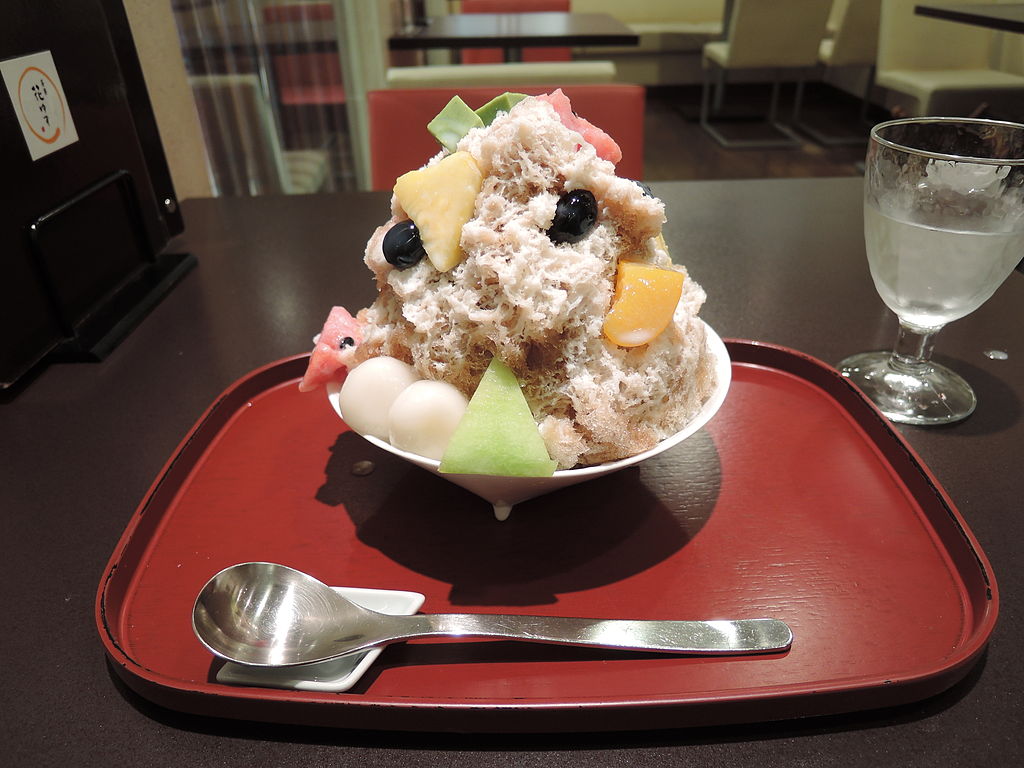May 23, 2017
Cool Down with Shaved Ice This Summer

If it is summer in Japan it is time for kakigori. Kakigori is the nation’s traditional hot weather treat – a mound of shaved ice sweetened with condensed milk and flavored with fruit or syrups. You can get your kakigori fix just about anywhere – in coffee shops, restaurants, at festivals, on street corners or in kakigori stores. Look for a ubiquitous red character that can be interpreted as whirring blades shaving ice (the blue region beneath); this is the symbol for kakigori.
Like many traditions in Japan, kakigori has a long history. There are accounts of shaved ice going back to the Heian period in the 11th century. To enjoy ice in the middle of summer meant cutting it in winter and storing it so kakigori was considered a luxury item that only nobles could afford to enjoy. A sharp knife was used to scrape the shavings into a metal bowl and sap from plants poured on top.
Kakigori for the masses arrived in the 1800s when merchant Kahe Nakagawa began transporting ice from Hakodate on the newly built railroad lines to supplement his butcher shop in Yokohama with sweets. The first kakigori shop opened for business in 1872. It did not take long for enterprising entrepreneurs to invent an automatic ice shaving machine to speed up the kakigori-making process.
It is the ice-making machine that is at the heart of kakigori. The shavings fall into piles more like freshly fallen snow than ice. The kakigori, in fact, is more like snow than the sno-cone that is popular in western countries. A sno-cone is much harsher than the smooth renderings from shaved-ice machines. In Japan these machines can be purchased to make home-made kakigori and you can still see some vendors hand-shaving large blocks of ice on Japan streets in the summer.
For those who believe that ice is ice, consider the fact that kakigori can also have snob appeal. Some sellers boast of the natural ice used in crafting the treat, none of that refrigerated water. Others even boast of their ice coming directly from the slopes of Mount Fuji.
Kakigori is popular enough to support entire chain operations. Ice Monster, based in Taiwan, crashed the shores of Japan with ice cafes (including in Osaka) in 2015 with its shaved-ice “Sensations.” Sulbing, with over 500 locations in Korea, is offering its own version of the summer treat.
Kakigori can be flavored with almost anything with seasonal summer fruit and green tea being the top choices. Kakigori is eaten with a spoon and brain freeze – that numbing sensation in your head when too much cold stimulation is consumed too quickly – is a real possibility. If this happens, press the cold bowl of shaved ice to your forehead; other kakigori lovers will recognize the symptoms and attempt at relief. Kakigori is meant to be savored slowly.
While you will want to indulge in shaved ice creations all summer long, the day of July 25 is one day you will certainly want to grab your kakigori spoon. That is the day the Japan Kakigori Association has declared to be “The Day of Kakigori” since the Japanese pronunciation of the date sounds a lot like “summer ice.”
By Mixtures (Own work) [CC BY 3.0], via Wikimedia Commons


About the author